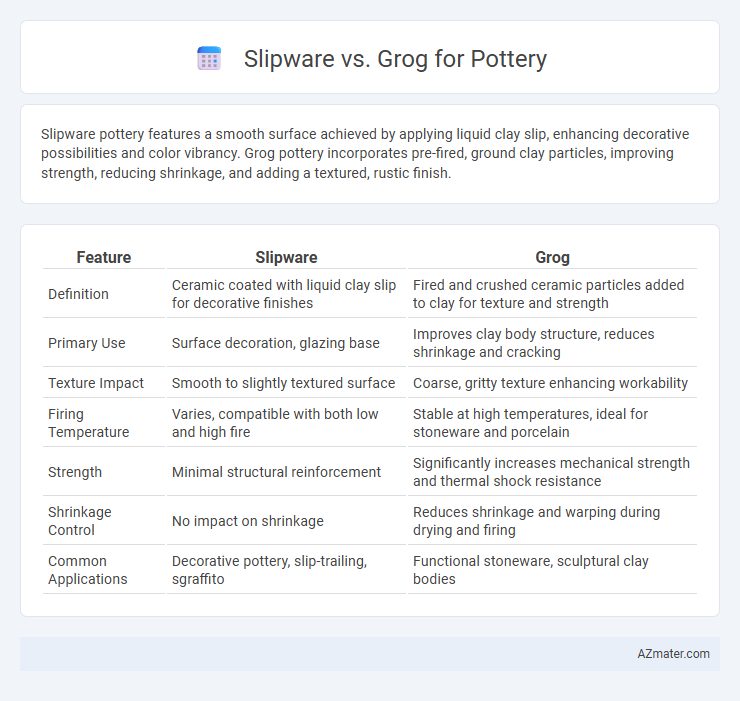Slipware pottery features a smooth surface achieved by applying liquid clay slip, enhancing decorative possibilities and color vibrancy. Grog pottery incorporates pre-fired, ground clay particles, improving strength, reducing shrinkage, and adding a textured, rustic finish.
Table of Comparison
| Feature | Slipware | Grog |
|---|---|---|
| Definition | Ceramic coated with liquid clay slip for decorative finishes | Fired and crushed ceramic particles added to clay for texture and strength |
| Primary Use | Surface decoration, glazing base | Improves clay body structure, reduces shrinkage and cracking |
| Texture Impact | Smooth to slightly textured surface | Coarse, gritty texture enhancing workability |
| Firing Temperature | Varies, compatible with both low and high fire | Stable at high temperatures, ideal for stoneware and porcelain |
| Strength | Minimal structural reinforcement | Significantly increases mechanical strength and thermal shock resistance |
| Shrinkage Control | No impact on shrinkage | Reduces shrinkage and warping during drying and firing |
| Common Applications | Decorative pottery, slip-trailing, sgraffito | Functional stoneware, sculptural clay bodies |
Introduction: Understanding Slipware and Grog
Slipware pottery is characterized by the application of liquid clay slip, which enhances surface decoration and texture, while grog refers to pre-fired, crushed ceramic particles added to clay to improve strength and reduce shrinkage. Understanding the distinct roles of slipware and grog is essential for potters aiming to balance aesthetics with functionality in ceramic creations. Slipware emphasizes design versatility and surface detail, whereas grog contributes to the structural integrity and workability of the clay body.
What is Slipware?
Slipware is a type of pottery characterized by the application of liquid clay slip onto the surface before firing, which creates decorative patterns or textures. The slip, often colored with natural or synthetic pigments, enhances both the aesthetic appeal and surface durability of the ceramic piece. Unlike grog, which is a granular additive mixed into the clay body to improve strength and reduce shrinkage, slipware primarily serves as a surface treatment to achieve artistic effects.
What is Grog in Pottery?
Grog in pottery refers to crushed, fired clay particles added to raw clay to improve its texture and durability during firing. This granular material enhances the clay's resistance to shrinkage and warping, making it ideal for wheel-thrown and hand-built pottery. Slipware, by contrast, uses liquid clay (slip) primarily for decoration or surface treatment rather than structural modification.
Key Differences Between Slipware and Grog
Slipware involves decorating pottery with liquid clay slip, which adds color and texture to the surface, whereas grog consists of pre-fired, crushed clay added to the clay body to enhance its strength and reduce shrinkage during firing. Slipware primarily serves an aesthetic function, providing decorative patterns, while grog improves the structural integrity and workability of the clay. The key differences lie in their purpose--slipware for surface decoration and grog for clay body reinforcement--and their physical form, with slipware being liquid and grog being granular.
Benefits of Using Slipware in Pottery
Slipware enhances pottery by providing a smooth, decorative surface that improves aesthetic appeal and allows for intricate designs. The use of slip--a liquid clay mixture--enables artisans to achieve vibrant colors and detailed patterns that are impossible with grog, which is primarily used for texture and strength. Slipware also promotes better glaze adherence, resulting in a durable and visually striking finish.
Advantages of Adding Grog to Clay
Adding grog to clay enhances its structural integrity by improving thermal shock resistance and reducing shrinkage during firing, which minimizes cracking and warping. This tempering agent increases porosity and texture, facilitating better slip adherence and creating a more durable finished pottery piece. Grog's granular composition also aids in controlled drying, making the clay easier to work with for both hand-building and wheel-throwing techniques.
How Slipware and Grog Impact Pottery Techniques
Slipware enhances pottery techniques by allowing precise surface decoration and smooth texture application, improving visual appeal and tactile quality. Grog, composed of pre-fired clay granules, strengthens clay bodies by increasing thermal shock resistance and reducing shrinkage during firing, which supports more durable, larger, or sculptural forms. Combining slipware with grog enables potters to create detailed, resilient pieces that balance aesthetic detail with structural integrity.
Aesthetic Effects: Slipware vs Grog
Slipware enhances pottery by providing a smooth, colored surface ideal for intricate designs and vivid patterns, offering a refined and polished aesthetic. Grog, composed of ground fired clay, contributes a rough, textured finish that creates a rustic and tactile visual effect, emphasizing natural, earthy tones. The choice between slipware and grog significantly influences the final visual texture and decorative quality of ceramic pieces.
Durability and Functionality Comparison
Slipware pottery, characterized by a smooth, decorative slip applied before firing, typically offers moderate durability but excels in aesthetic versatility and surface finish. Grog, consisting of crushed fired clay added to the clay body, significantly enhances the pottery's durability by reducing shrinkage and increasing resistance to thermal shock, making it ideal for functional wares like cooking pots. The addition of grog improves the structural integrity and longevity of pottery compared to slipware, which is more focused on decorative appeal than heavy-duty functionality.
Choosing Between Slipware and Grog for Your Project
Choosing between slipware and grog for your pottery project depends on the desired texture and strength of the final piece. Slipware offers smooth, decorative surfaces ideal for detailed painting and glazing, while grog enhances clay body durability and reduces shrinkage, making it perfect for functional, coarse pottery. Consider the firing temperature and intended use of the pottery to determine whether slipware's gloss and color or grog's structural stability best suits your project needs.

Infographic: Slipware vs Grog for Pottery
 azmater.com
azmater.com